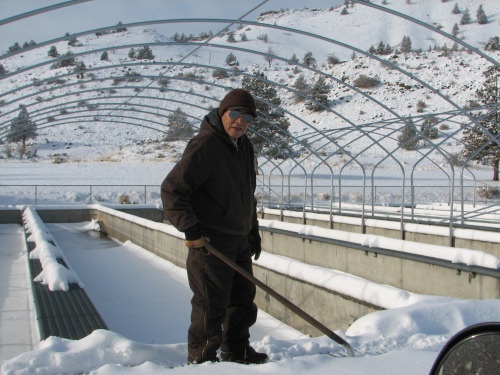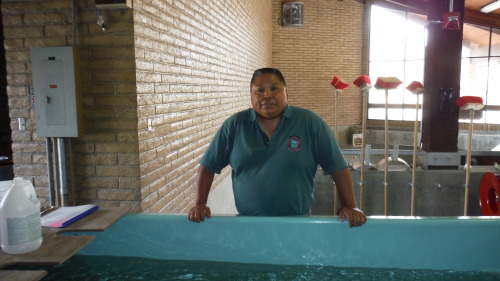 As springtime approaches, Chinook salmon return from the ocean to migrate upriver for their spawning season, signaling the start of fishing season for anglers in the Pacific Northwest. This is an especially important time for Native American Tribes, such as the Confederated Tribes of Warm Springs, to fish in their ancestral waters. With both human and environmental threats to wildlife, some fishing seasons have been better than others.
As springtime approaches, Chinook salmon return from the ocean to migrate upriver for their spawning season, signaling the start of fishing season for anglers in the Pacific Northwest. This is an especially important time for Native American Tribes, such as the Confederated Tribes of Warm Springs, to fish in their ancestral waters. With both human and environmental threats to wildlife, some fishing seasons have been better than others.

“There used to be a lot of fish in the river,” said Kevin Blueback (above top photo), Fish Culturalist for the Warm Springs National Fish Hatchery. “Right now, we’re just kind of replenishing the river, giving back to the river with the fish hatchery.”
The Warm Springs National Fish Hatchery is located on the Warm Springs Reservation in Oregon. The hatchery is co-managed by tribal members that assist with hatchery operations. The hatchery’s main role is to enhance fish runs in local waterways to meet the harvesting needs of the tribes.
Blueback is one of the staff members of the hatchery who is also an enrolled tribal member of the Confederated Tribes of Warm Springs. In his 20 years of experience working at the hatchery, he has observed that this year’s fishing season has been fair compared to other years.
“There was a few years where [the spring Chinook salmon] were pretty close to almost not coming back. I believe that was like in 1995, somewhere around that era, and there was not very many fish [returning],” Blueback recalled.
Joseph Badoni (above photo) is a Fish Culturalist and Animal Caretaker at the Warm Springs Hatchery and also affiliated with the Navajo tribe in Arizona. During his 12 years of working for the hatchery, he observed how the weather had slowed the process down for the salmon runs and the hatchery operations.
“Some years, we’ve had low returns, other times we’ve had quite a few fish return. Last year we had quite a bit of fish coming back,” Badoni said. He also adds that the high temperature in the water this year has affected the return of the salmon.

Roosevelt Heath (above photo) is a Fish Culturalist and Maintenance Worker for the Warm Springs Hatchery who is also an enrolled tribal member of the Confederated Tribes of Warm Springs.
Heath observed that the fish runs seem to be getting slower each year, but also pointed out that the Warm Springs Hatchery has been able to contribute to maintaining the fish population.
“We try to keep with the fish population, try to keep it balanced. That’s what our function is here,” Heath said.
‘Fishing is the way of life’
Blueback’s tribal affiliation includes his Warm Springs lineage through his mother and his Oklahoma Ponca lineage through his father, as well as Yakama and Coville affiliation. Blueback was inspired to work for fisheries by his father, who was a Fish and Wildlife Committee member and chairman. The work of his father inspired Blueback to help continue the work of fisheries while also helping tribal members.
Heath has been with the hatchery since April 2015. He was raised by his grandparents and grew up in the Warm Springs area, and has been fishing all of his life. According to Heath, members of the Confederated Tribes of Warm Springs harvest spring Chinook salmon, Pacific lamprey, and steelhead. The hatchery is responsible for supporting spring Chinook salmon populations.
During the salmon run from April through August, spring Chinook that migrate to the Warm Springs Reservation travel from the Pacific Ocean through the Columbia River, and continue upstream into the Deschutes River. From there, they return to the Warm Springs River to spawn, completing their 298-mile journey.
The role of the hatchery is to recover the previous hatchery fish returning from the ocean to manually spawn these adult fish, then raise and release their offspring to continue the salmon cycle. The salmon migration is also the best time for tribal members to fish.
Heath stated that supplying the Warm Springs River with plenty of salmon is very important for the tribes since salmon is the most important traditional food source.
“We serve fish and deer meat, and it’s pretty much all we have here, we have our traditional foods,” Heath said. “Evening gatherings, we have salmon. Our predominate meal is salmon, so it is pretty important for us to have it all the time.”
Other than providing plenty of salmon for the Warm Springs tribes, another way that the hatchery is able to give back to the tribes is to benefit the tribal members who work at the hatchery itself.
“A lot of people that can’t go fishing, they usually work [at the hatchery], and they get supplementation from the hatchery, so they can pick up some pink salmon after their work or during their work hours sometimes,” Blueback said.
During later times of the year, the Confederated Tribes of Warm Springs rely on other traditional food sources for sustenance. Blueback stated that fall Chinook from the nearby Deschutes River is a main traditional meat that is dried for winter use; other fish such as mountain whitefish and winter steelhead also provides through the winter, along with deer and elk meat.
Blueback, who was always taught that fishing was “the way of life” for his ancestors, knows that the work of the Warm Springs Hatchery serves an important function for the Confederated Tribes of Warm Springs. Since salmon remains an essential food source, the Warm Springs Hatchery continues to help tribal members continue the fishing traditions of their ancestors.
“Every year we have a salmon feast honoring the salmon, and giving blessings to the Creator for salmon returns,” Blueback said.
External Links:
